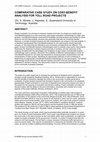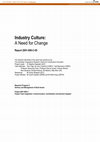Papers by Stephen Kajewski
CRC Press eBooks, Oct 29, 2009
Notice: Changes introduced as a result of publishing processes such as copy-editing and formattin... more Notice: Changes introduced as a result of publishing processes such as copy-editing and formatting may not be reflected in this document.
While all due care and attention has been taken to establish the accuracy of the material publish... more While all due care and attention has been taken to establish the accuracy of the material published, QUT, CSIRO, and the authors disclaim liability for any loss that may arise from any person acting in reliance upon the contents of this document. Copyright This document has been prepared in the course of a research project for the Information Industries Bureau, Department of Main Roads and Department of Public Works. It shall not be published, copied or cited whether directly or indirectly without the written approval of CSIRO and QUT.
2007-2008 > Academic research: refereed > Refereed conference pape

Strategic decision making at the front end of infrastructure projects, centred on the findings of... more Strategic decision making at the front end of infrastructure projects, centred on the findings of a business case, is critical to broader sustainability outcomes that align with the UN Sustainable Development Goals. However, in practice, there is no agreed approach to incorporating sustainability in appraisal. Decisions on major investments are often required to address guidelines providing a narrow frame of economic analysis using the comparison of costs with benefits or value. For public infrastructure decisions, point value analysis may preclude innovative project solutions that address the emerging challenges of climate change adaptation. This paper presents the findings of research seeking to understand an optimal system approach to support project selection and decision making for infrastructure projects within a strong sustainability framework. A sustainability investment logic is proposed that considers outcomes in terms of benefits that are measurable indicators and outputs in terms of values that may be both qualitative and quantitative. Benefits assessment for infrastructure investments should align with broader policy directions and include considerations of benefit for the wider community, beyond the boundaries of the infrastructure provider. A sustainability investment logic responds to calls for new approaches to investment appraisal to ensure that innovative and resilient infrastructure solutions are developed.

The decisions made within the initiating and planning phase of infrastructure projects provide th... more The decisions made within the initiating and planning phase of infrastructure projects provide the greatest opportunity to optimise sustainable outcomes at a broader level. Current practice continues to favour formal rationality using traditional economic appraisal to support decision making. A sustainability framework that recognises the institutional settings would broaden analysis to a social rationality model that takes account of the dynamic relationships and interactions that may exist between various actors with different world views. Within a sustainability framework, front-end decision making should involve the incorporation of sustainability goals from corporate planning documents; problem definition and option generation using investment management guidelines as evidenced by “best practice” investment management processes; comprehensive analysis of project options and impacts using a range of assessment tools; and greater involvement from the public to accurately reflect community values and local knowledge that may not be documented or understood by infrastructure providers. Applying a systems model, this policy level response needs to be supported within an institutional framework that takes account of the networks and interactions of the infrastructure provider and the overarching political and economic context with oversight provided by legislators and regulators.
Australasian Association for Engineering Education: Proceedings of the 8th Annual Convention and Conference, 1996
Supporting the project's research aims and objectives, and as a major deliverable for the project... more Supporting the project's research aims and objectives, and as a major deliverable for the project, this report is not intended as a comprehensive statement of best practice. Rather it should be read as an overall 'snapshot' of current public and private construction industry sector state-of-play concerning electronic tendering (e-Tendering)-ascertaining the barriers and enablers from both a technological and end-user perspective. v

ABSTRACT: This paper presents findings of a pilot study, which evaluates financial ratios in the ... more ABSTRACT: This paper presents findings of a pilot study, which evaluates financial ratios in the Indonesian construction Industry. The study is an extension of a larger study that is an attempt to identify the areas of strategic issues for Indonesian construction firms and develop an appropriate strategic management process for the firms to formulate, implement and evaluate. The findings are based on financial reports taken from all of construction companies listed in Surabaya Stock Exchange (SSX). The SSX has classified 6 firms in the construction sector. It has included both private and state owned firms. The research methodology adopted for this study includes data collection and analysis of firm annual reports and financial statements. There are some methods and techniques of financial ratio analysis in evaluating corporate performance of construction firms. Modified traditional ratios such as Liquidity, Leverage, Activity and Profitability ratios are adapted from Construction F...

Subcontracting has been widely used in order to address the high level of variability and associa... more Subcontracting has been widely used in order to address the high level of variability and associated risks in the complex configuration of residential construction production systems. However, the explosion of subcontracting and the parade of trades have made the construction operations very fragmented, leading to lack of predictability and adequate control on schedules and quality. The present paper proposes a set of system configurations for residential construction. On this basis, after an extensive review of the efforts to model construction production problems, several discrete event simulation models have been developed so as to assess tangible performance measures. Comparing and contrasting the results, two attributes of the system were found to be critical to yield better performance measures. In the proposed flexible system design, fewer cross-trained subcontractors undertake integrated work processes. Also, the number of houses under construction does not grow infinitely a...

Transport infrastructure is critical to well functioning communities across the globe. Roads are ... more Transport infrastructure is critical to well functioning communities across the globe. Roads are public assets that are provided for the common good of society. With long life spans, roads have significant impacts and benefits to local communities through the ability to shape land use and urbanisation, support economic and community development and generate consequences for local environments. In response to a series of international commitments to sustainable development, many infrastructure agencies adopt sustainability objectives at a corporate level and incorporate sustainability targets and indicators as part of corporate reporting processes. Road agencies are now incorporating sustainability considerations into the design, construction and operation phases of road projects using tools such as the Infrastructure Sustainability tool developed by the Infrastructure Sustainability Council of Australia (ISCA). However, the decisions made within the planning phase provide the greate...

Project evaluation is a process to measure impacts and risks of a project as a public good. Cost-... more Project evaluation is a process to measure impacts and risks of a project as a public good. Cost-Benefit Analysis is a most commonly used project evaluation methodology for major road projects. Cost-Benefit Analysis conducted for Australian toll road projects have tended to mirror those for non-toll road projects, because they generally treat tolls as a financial transfer. However, a number of project impacts and risk characteristics are unique to toll road projects. It is therefore hypothesised that Cost-Benefit Analysis for toll road projects should treat tolls uniquely, on the basis that risk allocations and concession arrangements are different. This paper reviews Cost-Benefit Analysis methodologies used to evaluate major public road projects. Examining the treatment of project impacts and risks in practice, and the outcomes of the analyses revealed both the advantages and limitations of each extant Cost-Benefit Analysis methodology used in practice. Moreover, the suitability of...

The Cooperative Research Centre for Construction Innovation (CRC CI) research project 2001-008-C:... more The Cooperative Research Centre for Construction Innovation (CRC CI) research project 2001-008-C: 'Project Team Integration: Communication, Coordination and Decision Support', is supported by a number of Australian industry, government and university based project partners including: Queensland University of Technology (QUT); Commonwealth Scientific Industrial Research Organisation (CSIRO), University of Newcastle; Queensland Department of Public Works (QDPW); and the Queensland Department of Main Roads (QDMR). Supporting the project’s research aims and objectives, and as a major deliverable for the project, this report is not intended as a comprehensive statement of the construction industry's need or ability to change its existing culture. Rather, this report provides an overall snapshot of 'general' industry organisation experiences, characteristics and cultural attributes towards implementing a cultural or technological driven change, and considered as 'b...
by the CRC for Construction Innovation. This delegation is contained in Clause 30

Science & Engineering Faculty, 2016
The movement to protect heritage places has grown enormously in Australia over the past decade. T... more The movement to protect heritage places has grown enormously in Australia over the past decade. The renewed recognition of the significant roles that heritage places play in the urban environment today is encouraging but has a way to go if the demolition of memorable places and irreversible loss of intangible values seen in previous times is to be discontinued. This study investigated the perceptions of the general public and the professional stakeholders in heritage projects and found that they were very similar, particularly in relation to the reasons for heritage retention. The results indicate that, while there is growing interest in sustaining the reflection of the historic urban landscape by retaining cherished icons for the future, there needs to be better ways to overcome the modern development pressures on heritage sites. The paper concludes that, despite the challenges in heritage retention, they are outweighed by the value that accrues from preserving heritage places and ...
The Participants of the CRC for Construction Innovation have delegated authority to the CEO of th... more The Participants of the CRC for Construction Innovation have delegated authority to the CEO of the CRC to give Participants permission to publish material created by the CRC for Construction Innovation. This delegation is contained in Clause 30 of the Agreement for the ...

Proceedings of the International Conference on Civil Infrastructure and Construction (CIC 2020), 2020
Process improvement and innovation in the field of road construction sector offers significant co... more Process improvement and innovation in the field of road construction sector offers significant community and industry benefits, by making an important contribution in economic growth and enhancing the quality of life. However, achieving better innovative practices in order to improve existing construction processes and to heighten competitiveness have gradually become a challenge for the road industry. The use of innovation in this context refers to the use of suitable materials in the construction of road, material such as eco-friendly roads, solar roads and recycled materials. This paper examines 12 different case studies on the uses of new material in road construction and where case studies are from different countries in different context and explores the usefulness of the practices under numerous road situation and conditions. The case studies have been analyzed in the following context: location of the case study, which helps to identify the suitability of road construction material with the weather condition; driving factors, which indicates, how and what selected case studies contribute in the field of innovation; economy and environment feasibility; and barriers in the case studies, which indicates hurdles to implement selected case studies. The study findings indicate that in order to maintain competitiveness, construction industry needs to continuously focus on the improvement of their construction processes and innovative materials. Finding indicates that in most case studies both economic and environmental benefits were realized.











Uploads
Papers by Stephen Kajewski